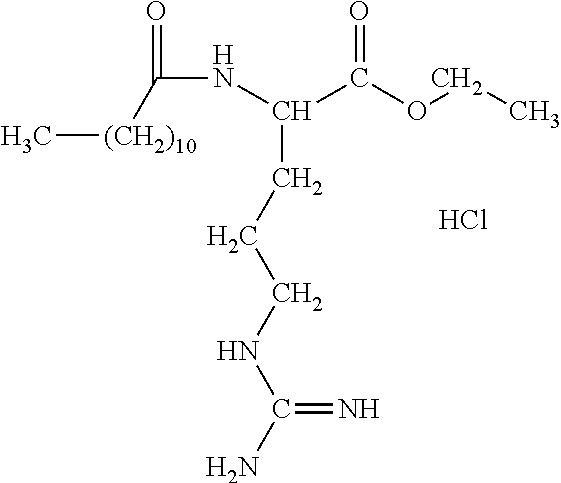Antimicrobial films, sponges and sponge cloths
a technology of sponge cloth and antimicrobial film, which is applied in the direction of liquid/solution decomposition chemical coating, solid/suspension decomposition chemical coating, superimposed coating process, etc., can solve the problems of cellulose sponge cloth, glycerol monolaurate or isothiazolone not offering sufficient protection at high moisture, and the effect of reducing the antimicrobial action
- Summary
- Abstract
- Description
- Claims
- Application Information
AI Technical Summary
Benefits of technology
Problems solved by technology
Method used
Image
Examples
example 1
[0035]An externally-viscosed cellulose hydrate flexible tube having a fiber paper insert of caliber 60 was, before entry into the dryer, passed through an impregnation trough which contained a 4% aqueous solution of LAECI and 3% glyoxal, based on the active substance.
[0036]Into the interior of the flexible tube was charged a customary adhesion impregnating solution (casein+glyoxal); the flexible tube was dried in the inflated state and moistened to 16 to 18%. During shirring of the casing, the moisture content was then increased to 25±2% by internal mandrel spraying; the non-soaked shirred sticks sealed into film did not show any mold or bacterial infestation after storage for any desired period under standard or tropical conditions.
[0037]In the ripening of dry or semidry sausage, likewise no mold formation was observed.
example 2
[0038]A double-viscosed cellulose hydrate fiber flexible tube of caliber 60 having a viscose distribution 30 / 70 (exterior / interior) was, in the gel state before entry into the dryer, passed through an aqueous solution which contained 5% LAECI, 1% para-hydroxybenzoic acid methyl ester and 3% glyoxal, based on the active substance.
[0039]A customary adhesion impregnation for dry or semidry sausage was charged into the flexible tube interior; the flexible tube was then dried to 8 to 10% moisture in the inflated state. The shirred sticks were charged with dry or semidry sausage emulsion; during ripening they also remained mold-free even next to mold-ripened sausages.
example 3
[0040]A double-viscosed cellulose hydrate flexible tube of caliber 60 having a viscose distribution 40 / 60 (exterior / interior), in the gel state before entry into the dryer, is passed through an aqueous solution which contained 6% LAECI and 3% glyoxal, based on the weight of the active substance.
[0041]A customary anchoring solution was charged into the flexible tube interior. The flexible tube was, as is customary, dried in the inflated state, wound up and internally coated with a PVDC dispersion in a second process step. Meat sausage emulsion was charged into sections of the sausage casing that were tied off at one end, and the sausages were then given a second packaging in film.
[0042]After a storage time of 6 weeks, still no mold infestation could be observed. On the cooked, inoculated long-life samples, after a 4-week incubation period, likewise no mold developed.
PUM
| Property | Measurement | Unit |
|---|---|---|
| Length | aaaaa | aaaaa |
| Flexibility | aaaaa | aaaaa |
| Antimicrobial properties | aaaaa | aaaaa |
Abstract
Description
Claims
Application Information
 Login to View More
Login to View More - R&D
- Intellectual Property
- Life Sciences
- Materials
- Tech Scout
- Unparalleled Data Quality
- Higher Quality Content
- 60% Fewer Hallucinations
Browse by: Latest US Patents, China's latest patents, Technical Efficacy Thesaurus, Application Domain, Technology Topic, Popular Technical Reports.
© 2025 PatSnap. All rights reserved.Legal|Privacy policy|Modern Slavery Act Transparency Statement|Sitemap|About US| Contact US: help@patsnap.com

